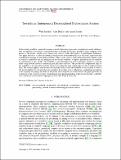Towards an autonomous decentralized orchestration system
Abstract
Orchestrating workflows needed for modern scientific data analysis presents a significant research challenge: they are typically executed in a centralized manner such that all data pass through a single compute server known as the engine, which causes unnecessary network traffic that leads to a performance bottleneck. This paper presents a scalable decentralized orchestration system that relies on a functional, high‐level data coordination language for executing workflows. This system consists of distributed execution engines, each of which is responsible for executing part of the overall workflow. It exploits parallelism in the workflow by partitioning it into smaller sub‐workflows and determines the most appropriate engines to execute them using network resource monitoring and placement analysis. This permits the computation logic of the workflow to be moved towards the services providing the data, which improves the overall execution time. The system supports data‐driven execution that allows each sub‐workflow to be executed as soon as the data needed for its execution become available from other sources. Therefore, a scheduling mechanism is not required to manage the order in which the sub‐workflows are orchestrated. This paper provides an evaluation of the proposed system, which demonstrates that decentralized orchestration provides scalability over centralized orchestration.
Citation
Jaradat , W , Dearle , A & Barker , A 2016 , ' Towards an autonomous decentralized orchestration system ' , Concurrency and Computation : Practice and Experience , vol. 28 , no. 11 , pp. 3164-3179 . https://doi.org/10.1002/cpe.3655
Publication
Concurrency and Computation : Practice and Experience
Status
Peer reviewed
ISSN
1532-0634Type
Journal article
Collections
Items in the St Andrews Research Repository are protected by copyright, with all rights reserved, unless otherwise indicated.

